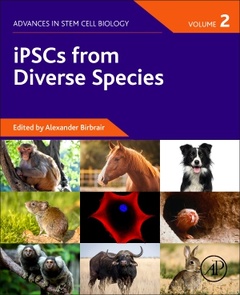iPSCs from Diverse Species Advances in Stem Cell Biology Series
Coordonnateur : Birbrair Alexander

The series Advances in Stem Cell Biology is a timely and expansive collection of comprehensive information and new discoveries in the field of stem cell biology.
iPSCs from Diverse Species, Volume 2 addresses how induced pluripotent stem cells (iPSCs) can be derived from different species.
The volume teaches the reader about modern state-of-the-art methodologies to derive iPSCs from distinct species. This volume will cover how to derive iPSCs from species like nonhuman primates, horses, dogs, pigs, rats, rabbits, and others. It also discusses the importance of iPSCs in species conservation. Detailed description on methods used to obtain iPSCs from humans and other species expands the knowledge and understanding of stem cell biology and provides a potent tool to model diseases.
The volume is written for researchers and scientists in stem cell biology, and regenerative medicine and is contributed by world-renowned authors in the field.
1. Human iPSCs and Their Uses in Developmental Toxicology 2. Induced Pluripotent Stem Cells from Non-Human Primates 3. Equine Induced Pluripotent Stem Cells 4. Canine Induced Pluripotent Stem Cells: An In Vitro Approach to Validate the Dog as a Large Animal Model for Alzheimer’s Disease 5. Porcine iPSCs 6. Bovine iPSC and applications in precise genome engineering 7. Induced Pluripotent Stem Cells from Buffalo 8. Establishment of Induced Pluripotent Stem Cell from Prairie Vole Derived Fibroblast 9. Rabbit Induced Pluripotent Stem Cells: The Challenges 10. Naked Mole Rat iPSCs and Their Non-Canonical Features: A Novel Tool for Aging Research 11. Induced Pluripotent Stem Cells in Species Conservation: Advantages, Applications and the Road Ahead
- Provides overview of the fast-moving field of iPSC technology
- Covers iPCSs from the following species: humans, monkeys, horses, dogs, pigs, rats, rabbits, and more
- Consists of contributions from stem cell leaders around the world
Date de parution : 10-2020
Ouvrage de 272 p.
19x23.3 cm
Thème d’iPSCs from Diverse Species :
Mots-clés :
a-Actinin (ACTN2); ß-Globin haplotype; ß-Myosin heavy chain (MYH7); Actin (ACTC1); Aging; Alpha thalassemia; Angiogenesis; Animal models; Aortic aneurysm; Autophagy; BCL11A; Bernard-Soulier syndrome; Bleeding disorders; Blood-brain barrier; Bone marrow failure; CADASIL; Cardiac troponin T (TNNT2); Cardiovascular disease; Cell-based therapy; Cell/gene therapy; Cellular reprogramming; Clonal evolution; Congenital bone marrow failure syndrome; CRISPR/Cas; CSF3; CSF3R; Current DMD therapy; Cystinosis; Danon disease; Definitive erythropoiesis; Diamond-Blackfan anemia; Differentiation; Dilated cardiomyopathy (DCM); Disease mechanisms; Disease modeling; DNA polymerase; Drug screening; Duchenne muscular dystrophy; ELANE; Elastin; Elastin-associated vasculopathy; Endothelial cell; Engineered vascular tissue ring; Erythroid differentiation; ES-Sac; Exon skipping; Exonuclease; Extracellular matrix; F-cell; Fabry disease; Fetal hemoglobin; Gaucher disease; Gene editing; Gene mutations; Genome editing; Giant platelet; Globin genes; Glycoprotein; Glycoprotein Ib-IX-V; GM1 gangliosidosis; Growth factor therapy; HAX1; Helical; Hematopoietic progenitor cells; Hemoglobin switching; Hemolytic anemia; Hepatocyte; Hereditary thrombocytopenia; Heteroplasmy; Homoplasmy; HPFH; Human embryonic stem cells; Hypertrophic cardiomyopathy (HCM); In vitro differentiation; Induced pluripotent stem cell; Induced pluripotent stem cells; Induced pluripotent stem cells (iPSCs); iPSC; iPSC-myogenic progenitors; iPSC-derived cardiomyocytes; iPSC-derived models; iPSCs; Kearns-Sayre syndrome; Leigh syndrome; Leukemia predisposition; Leukemic transformation; LHON; Lipoprotein cholesterol regulation; Liver; Low-density lipoprotein receptor; Lysosomal acid lipase deficiency; Lysosomal storage diseases; Macrothrombocytopenia; Marfan syndrome; Megakaryocyte; MELAS; MERRF; Mesenchymal cells; Metachromatic leukodystrophy; MIDD



